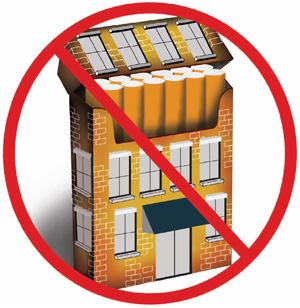OPEN DOORS The key to any successful smoke-free policy is a strategic communications plan. First, firms should consider conducting a resident survey and hosting a community meeting to discuss a new smoking policy well in advance of implementing such a change. A survey will help firms determine how many residents actually smoke in their apartments and common areas so they can assess how a particular community could be impacted by new rules. It also will help firms decide whether smoking restrictions should be applied to all or some apartment units, common areas, or outdoor space.
Surveys and community meetings are valuable ways for firms to identify what issues residents really care about, where residents are willing to compromise and where they are not. Residents will be more amenable to new smoking rules if they have been invited to communicate their perspective on the matter and are advised of the new rules before they are put into practice.
It is important to ensure that community managers, leasing consultants, and other site-level staff are knowledgeable about smoking policies. It is equally important that they are well trained in communicating the policy to prospective residents, current residents, and guests, both as an enforceable lease provision and as a community amenity. Recent resident surveys conducted by numerous organizations across the country, including the King County (Washington) Housing Authority, the American Lung Association of California, and the Portland-Vancouver Metro Area Smokefree Housing Project, indicate that a majority of renters would prefer to rent an apartment in a smoke-free community. In addition, about half say they have moved or would move because of secondhand smoke.
Still, as with any change to community rules, a new smoke-free policy must be “sold.” Site staff should be prepared to present all of the positive aspects of the new rules. For example, discussions with residents and/or brochures might cover the scientific conclusion that there is no safe level of secondhand smoke and how allowing smoking impacts all residents by increasing fire hazard, threatening residents’ personal property, and increasing operating costs—and thus rent—because of higher cleaning costs. Indeed, it is more expensive to turn a unit where a smoker resided; some experts estimate that cleaning walls, carpets, appliances, and fixtures that were exposed to smoke can add $400 to $3,000 to unit turnover costs, depending on the length of residency and how much the resident smoked in the unit.
To build good will, encourage resident compliance, and speed up implementation, communities could offer incentives to those who are willing to go smoke-free prior to their lease renewal. Prospective residents should be advised of a community’s smoke-free policy in writing at the time of an application, if not before. Residents should also be reminded that there is no legal right to smoke, even in a leased apartment.
Achieving resident buy-in is essential to enforcement since residents likely will be the most effective means of identifying violators. Residents need to understand and feel positive about the policy, and they should feel comfortable communicating potential violations to community staff.
Betsy Feigin Befus is vice president of employment policy and special counsel for the Washington, D.C.-based National Multi Housing Council.
